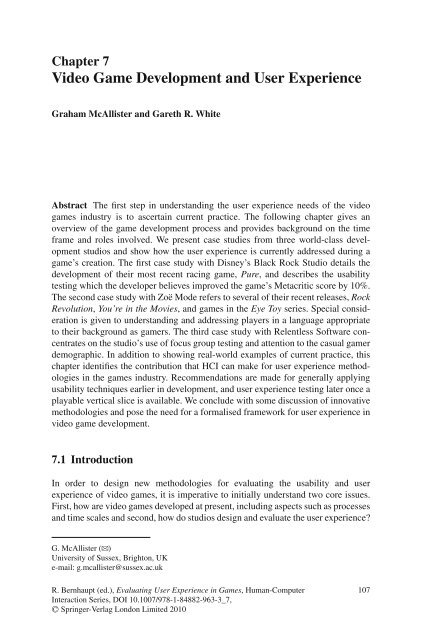Evaluating User Experience in Games: Concepts and Methods - Lirmm
Evaluating User Experience in Games: Concepts and Methods - Lirmm
Evaluating User Experience in Games: Concepts and Methods - Lirmm
You also want an ePaper? Increase the reach of your titles
YUMPU automatically turns print PDFs into web optimized ePapers that Google loves.
Chapter 7<br />
Video Game Development <strong>and</strong> <strong>User</strong> <strong>Experience</strong><br />
Graham McAllister <strong>and</strong> Gareth R. White<br />
Abstract The first step <strong>in</strong> underst<strong>and</strong><strong>in</strong>g the user experience needs of the video<br />
games <strong>in</strong>dustry is to ascerta<strong>in</strong> current practice. The follow<strong>in</strong>g chapter gives an<br />
overview of the game development process <strong>and</strong> provides background on the time<br />
frame <strong>and</strong> roles <strong>in</strong>volved. We present case studies from three world-class development<br />
studios <strong>and</strong> show how the user experience is currently addressed dur<strong>in</strong>g a<br />
game’s creation. The first case study with Disney’s Black Rock Studio details the<br />
development of their most recent rac<strong>in</strong>g game, Pure, <strong>and</strong> describes the usability<br />
test<strong>in</strong>g which the developer believes improved the game’s Metacritic score by 10%.<br />
The second case study with Zoë Mode refers to several of their recent releases, Rock<br />
Revolution, You’re <strong>in</strong> the Movies, <strong>and</strong> games <strong>in</strong> the Eye Toy series. Special consideration<br />
is given to underst<strong>and</strong><strong>in</strong>g <strong>and</strong> address<strong>in</strong>g players <strong>in</strong> a language appropriate<br />
to their background as gamers. The third case study with Relentless Software concentrates<br />
on the studio’s use of focus group test<strong>in</strong>g <strong>and</strong> attention to the casual gamer<br />
demographic. In addition to show<strong>in</strong>g real-world examples of current practice, this<br />
chapter identifies the contribution that HCI can make for user experience methodologies<br />
<strong>in</strong> the games <strong>in</strong>dustry. Recommendations are made for generally apply<strong>in</strong>g<br />
usability techniques earlier <strong>in</strong> development, <strong>and</strong> user experience test<strong>in</strong>g later once a<br />
playable vertical slice is available. We conclude with some discussion of <strong>in</strong>novative<br />
methodologies <strong>and</strong> pose the need for a formalised framework for user experience <strong>in</strong><br />
video game development.<br />
7.1 Introduction<br />
In order to design new methodologies for evaluat<strong>in</strong>g the usability <strong>and</strong> user<br />
experience of video games, it is imperative to <strong>in</strong>itially underst<strong>and</strong> two core issues.<br />
First, how are video games developed at present, <strong>in</strong>clud<strong>in</strong>g aspects such as processes<br />
<strong>and</strong> time scales <strong>and</strong> second, how do studios design <strong>and</strong> evaluate the user experience?<br />
G. McAllister (B)<br />
University of Sussex, Brighton, UK<br />
e-mail: g.mcallister@sussex.ac.uk<br />
R. Bernhaupt (ed.), <strong>Evaluat<strong>in</strong>g</strong> <strong>User</strong> <strong>Experience</strong> <strong>in</strong> <strong>Games</strong>, Human-Computer<br />
Interaction Series, DOI 10.1007/978-1-84882-963-3_7,<br />
C○ Spr<strong>in</strong>ger-Verlag London Limited 2010<br />
107

















